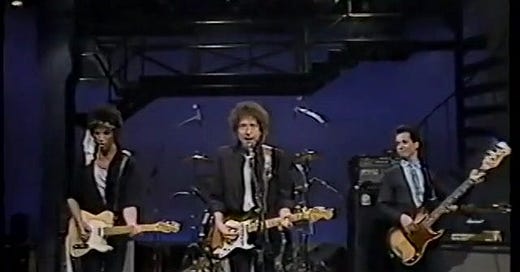The Letterman Jokerman
Bob Dylan’s Letterman appearance in 1984 is one of the iconic Dylan moments. But what really happened? Planned chaos. And why is it so special? Because it displays Dylan's art form in pure form.
Bob Dylan’s 1984 performance at the Letterman show is one of those iconic moments in his career. Maybe not as famous as going electric at Newport 1965, but among fans it is up there with Prague 1995, the Bangla Desh concert, and the Rolling Thunder Revue.
It is a prime example of Dylan accepting chaos, drawing meaning from it, and as such it gives a unique glimpse into his creative mind.
Revised version of a text originally published in Dylanology No. 3 (2021/07)
What happened at Letterman?
The actual events are well known: Dylan had been touring as a brimstone-fuming gospel preacher for a couple of years (1979–1981), then released the slick, polished reggae-light album Infidels and was asked to perform at the new, hip, cool Letterman TV show. The deal was: “No interview, no chit-chat, I bring my own band.”
Dylan then hung out with a bunch of musicians, who had no idea that they were in fact auditioning for a legendary spot on national TV. The unsuspecting victims were the latino-punk LA-band the Plugz, who Dylan knew because his kids were fans of the band.
Initially they were just fooling around, jamming. Then Dylan suddenly asked them if they wanted to go to New York and play on Letterman. They went through fifty different songs but had no idea what they were going to play until Dylan turned around to the band, on stage, while the live cameras were rolling, and said: “Let’s do Sonny Boy”.
They quickly decide on a key and play Sonny Boy Williamson’s “Don’t Start Me Talking”. It’s about as far from Infidels as it could possibly be, and Dylan is elated, jumping up and dropping to his knees, hollering with glee.
The Jokerman Arrives
Next up is “Licence to Kill”, and then comes “Jokerman”.
What has made this particular performance legendary happens after the first three verses. Dylan stops playing, puts down his guitar, goes to the side to pick up a harmonica, starts blowing, realises that it’s in the wrong key, then fumbles around with his back to the world, communicates with the responsible roadie, says a few words to the guitar player (“Keep playing!” probably), then finds the right harp, jumps in, plays another verse of solo, and that’s it: the stuff legend is made of.
But why is that, actually? What is it about the events and the performance itself that is so special?
It is my contention that the Letterman performance is special because it seems to mean something special, to be particularly meaningful, and it is also a particularly apt example of how it is that Dylan makes meaning with his music in general.
The overall reaction upon hearing the performance might run something like this:
It is raw, aggressive, un-pretty, with a lot of punch,
and all the time on the verge of breaking down;
it is blisteringly fast,
and the false notes from the wrong harmonica just confirm
the overall impression of a chaos
that the musicians miraculously manage to work their way out of.
and the answer to the question “what does it mean?” as well as to the derivative questions – from the artist’s perspective: “Why did he do this?” and from the listeners’: “Why do we like it so much?” – can perhaps be found somewhere in this list. Let’s see.
Keep reading with a 7-day free trial
Subscribe to Dylanology to keep reading this post and get 7 days of free access to the full post archives.




